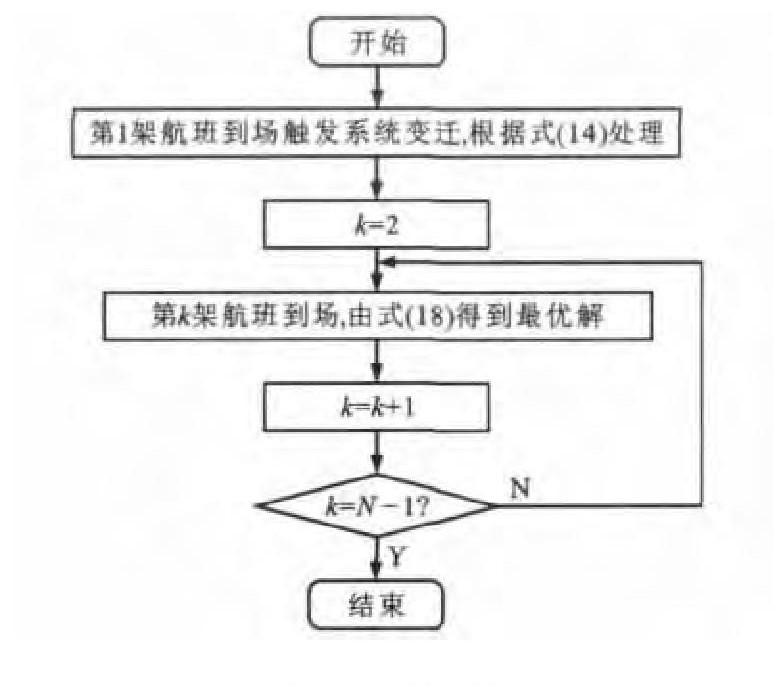Optimization model of ground-holding problem in airport flow management
-
摘要: 分析了目标机场到场容量和到场需求的随机特性, 以所有航班总的延迟费用最小为目标函数, 以先到先服务原则、机场到场容量限制、地面等待和空中延迟的关系为约束条件, 建立了机场流量管理中地面等待问题的数学规划模型和事件驱动模型。运用基本的遗传算法求解模型, 得出了优化后航班的具体到场时间。计算结果表明: 单位时间的空中延迟和地面等待费用比越大, 空中延迟越容易被转化为地面等待; 当单位时间的空中延迟和地面等待费用比为3∶1时, 优化后的航班延迟总费用下降50%;当单位时间的空中延迟和地面等待费用比为1∶1时, 空中延迟和地面等待时间的比值约为1.058;当单位时间的空中延迟和地面等待费用比为6∶1时, 空中延迟只有地面等待时间的4.77%。优化后, 航班的到场分布更加均衡, 优化结果将更为精确。Abstract: The stochastic features of arrival capacity and arrival demand for target airport were analyzed.The minimum total flight delay cost was taken as objective function, the principle of first come first service, the limits of airport arrival capacity and the relation between groundholding and air-delay were considered as constraint conditions, and the mathematical programming model and event-driven model of grounding-holding problem in airport flow management were built.The basic genetic algorithm was designed to solve the models, the concrete arrival times after optimization were calculated.Calculation result shows that the bigger the ratio of unit air-delay cost to unit ground-holding cost is, the more easily the air-delay turns to ground-holding.When the ratio of unit air-delay cost to unit ground-holding cost is 3∶1, the total delay costs reduce by 50% after optimization.When the ratio of unit air-delay cost to unit ground-holding cost is 1∶1, the time ratio of air-delay to ground-holding is about 1.058.When the ratio of unit air-delay cost to unit ground-holding cost is 6∶1, the time ratio of air-delay to ground-holding is about 4.77%.After optimization, the flight arrival distribution is more statuesque, and the optimized result is more accurate.
-
Key words:
- airport flow management /
- ground-holding /
- arrival capacity /
- arrival demand /
- genetic algorithm
-
表 1 到场容量样本量
Table 1. Arrival capacity samples

表 2 到场需求样本量
Table 2. Arrival demand samples

表 3 延迟时间与费用对比
Table 3. Comparison of delay cost

表 4 优化结果
Table 4. Optimization results

-
[1] ODONI A R. The flow management problem in air traffic control[R]. Berkeley: University of California-Berkeley. 1987. [2] BERTSIMAS D, STOCK S. The air traffic flow management problem with enroute capacities[J]. Operations Research, 1998, 46 (3): 406-422. doi: 10.1287/opre.46.3.406 [3] HOFFMAN R, BALL M O. A comparison of formulations for the single-airport ground holding problem with banking constraints[J]. Operations Research, 2000, 48 (4): 578-591. doi: 10.1287/opre.48.4.578.12417 [4] BRUNETTA L, GUASTALLA A G, NAVAZIO L. A new approach for solving the multi airport ground holding problem[R]. Padova: University of Padova, 1995. [5] BALL M O, HOFFMAN R, ODONI A R, et al. The static stochastic ground holding problem with aggregate demands[R]. Berkeley: University of California-Berkeley, 1999. [6] VRANAS P, BERTSIMAS D, ODONI A R. Dynamic groundholding policies for a network of airports[J]. Transportation Science, 1994, 28 (4): 275-291. doi: 10.1287/trsc.28.4.275 [7] WANG Lai-jun, SHI Zhong-ke. A discrete event system approach for solving the ground holding problem[J]. Journal of System Simulation, 2004, 16 (10): 2270-2272, 2293. [8] ANDREATTA G, ROMANIN-JACUR G. Aircraft flow management under congestion[J]. Transportation Science, 1987, 21 (4): 249-253. doi: 10.1287/trsc.21.4.249 [9] HOFFMAN R. Integer programming models for groundholding in air traffic flow management[D]. College Park: University of Maryland, 1997. [10] RIFKINR M. The single airport static stochastic ground holding problem[D]. Cambridge: Massachusetts Institute of Technology, 1998. [11] BALL M O, HOFFMAN R, ODONI A R, et al. Efficient solution of a stochastic ground holding problem[J]. Operations Research, 2003, 51 (1): 167-171. doi: 10.1287/opre.51.1.167.12795 [12] RICHETTA O, ODONI A R. Dynamic solution to the ground holding problem in air traffic control[J]. Transportation Research Part A: Policy and Practice, 1994, 28 (3): 167-185. doi: 10.1016/0965-8564(94)90015-9 [13] PANAYIOTOU G, CASSANDRAS G. A sample path approach for solving the ground-holding policy problem in air traffic control[J]. Transactions on Control Systems Technology, 2001, 9 (3): 510-524. doi: 10.1109/87.918903 [14] VRANAS P, BERTSIMAS D, ODONI A R. The multiairport ground-holding problem in air traffic control[J]. Operations Research, 1994, 42 (2): 249-261. doi: 10.1287/opre.42.2.249 [15] ANDREATTA G, BRUNETTA L. Multi-airport ground holding problem: a computational evaluation of exact algorithms[J]. Operations Research, 1998, 46 (1): 57-64. doi: 10.1287/opre.46.1.57 [16] 肖潇, 雷秀娟. IPSO算法用于确定型单机场地面等待问题[J]. 计算机工程与应用, 2009, 45 (24): 231-234. https://www.cnki.com.cn/Article/CJFDTOTAL-JSGG200924072.htmXIAO Xiao, LEI Xiu-juan. Deterministic single-airport ground-holding program based on particle swarm optimization algorithm[J]. Computer Engineering and Applications, 2004, 45 (24): 231-234. (in Chinese). https://www.cnki.com.cn/Article/CJFDTOTAL-JSGG200924072.htm [17] 王莉莉, 史忠科. 单机场地面等待问题遗传算法设计[J]. 系统仿真学报, 2006, 18 (4): 894-896, 912. https://www.cnki.com.cn/Article/CJFDTOTAL-XTFZ200604021.htmWANG Li-li, SHI Zhong-ke. To solve single airports groundholding problem with genetic algorithm[J]. Journal of System Simulation, 2006, 18 (4): 894-896, 912. (in Chinese). https://www.cnki.com.cn/Article/CJFDTOTAL-XTFZ200604021.htm [18] 张玉洲. 机场地面等待问题建模及进化优化研究[D]. 合肥: 中国科学技术大学, 2011.ZHANG Yu-zhou. A study on modeling and evolutionary optimization for airport ground-holding problem[D]. Hefei: University of Science and Technology of China, 2011. (in Chinese). [19] 郎茂祥. 基于遗传算法的物流配送路径优化问题研究[J]. 中国公路学报, 2002, 15 (3): 76-79. https://www.cnki.com.cn/Article/CJFDTOTAL-ZGGL200203017.htmLANG Mao-xiang. Study of the optimizing of physical distribution routing problem based on genetic algorithm[J]. China Journal of Highway and Transport, 2002, 15 (3): 76-79. (in Chinese). https://www.cnki.com.cn/Article/CJFDTOTAL-ZGGL200203017.htm -





 下载:
下载:




















